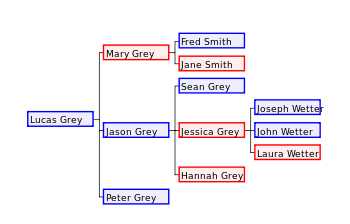Family tree: Difference between revisions
Bongwarrior (talk | contribs) m Reverted edits by Rasberry15 (talk) to last version by 12.76.130.142 |
Rasberry15 (talk | contribs) mNo edit summary |
||
| Line 51: | Line 51: | ||
[[it:Albero genealogico]] |
[[it:Albero genealogico]] |
||
[[hu:Családfa]] |
[[hu:Családfa]] |
||
[[nl:Stamboom]] I hate myself!!!!!!!!!!!!!!!!!!!!!!!!!!!!!!! |
|||
[[nl:Stamboom]] |
|||
[[pl:Drzewo genealogiczne]] |
[[pl:Drzewo genealogiczne]] |
||
[[pt:Árvore genealógica]] |
[[pt:Árvore genealógica]] |
||
Revision as of 22:41, 29 November 2008

A family tree is a chart representing family relationships in a conventional tree structure. The more detailed family trees used in medicine, genealogy, and social work are known as genograms.
Family tree representations
Genealogical data can be represented in several formats, for example as a pedigree or ancestor chart (see links below). Family trees are often presented with the oldest generations at the top and the newer generations at the bottom. An ancestry chart, which is a tree showing the ancestors of an individual, will more closely resemble a tree in shape, being wider at the top than the bottom (illustration below in "The Family Tree of Sigmund"). In some ancestry charts, an individual appears on the left and his or her ancestors appear to the right (see Lucas Grey tree above). A descendancy chart, which depicts all the descendants of an individual will be narrowest at the top.

Family trees can have many different themes. One might encompass all descendants of a single figure, or all known ancestors of a living person. Another might include all members of a particular surname (e.g. male-line descendants). Yet another approach is to construct a tree including all holders of a certain office, such as kings of Germany. This relies on dynastic marriage to hold together the links between dynasties.
The image of the tree probably originated with one in medieval art of the Tree of Jesse, used to illustrate the Genealogy of Christ in terms of a prophecy of Isaiah (Isaiah, 11, 1). Possibly the first non-Biblical use, and the first to show full family relationships rather than a purely patrilineal scheme, was that involving family trees of the classical gods in Boccaccio's Genealogia deorum gentilium (On the Genealogy of the Gods of the Gentiles), whose first version dates to 1360.

The longest family tree in the world today is that of the Chinese philosopher and educator Confucius (551-479 BC). The tree spans more than 80 generations, and includes more than 2 million members. An international effort involving more than 450 branches around the world was started in 1998 to retrace and revise this family tree. The latest findings will be published next year (2009) by the Confucius Genealogy Compilation Committee to coincide with the 2560th anniversary of the birth of the Chinese thinker. This latest edition is expected to include some 1.3 million living members who are scattered around the world today.[1]
See also
- Ahnentafel
- Genealogy software
- Cousin chart (Table of consanguinity)
- Genealogical numbering systems
- Genogram
- List of family trees
- Pedigree chart
- Wikipedia:Family trees
References
External links
- FamilySearch.org
- Public records and useful guides on obtaining copies of certificates (UK)
- Free BMD UK vital records indexes
- 1901 Census (UK)
- USGenWeb Project I hate myself!!!!!!!!!!!!!!!!!!!!!!!!!!!!!!!
